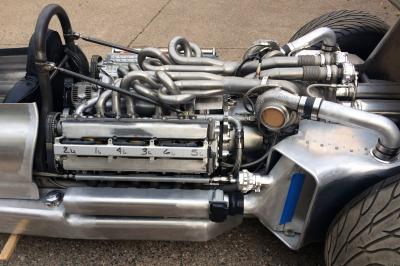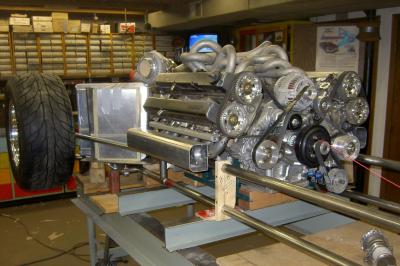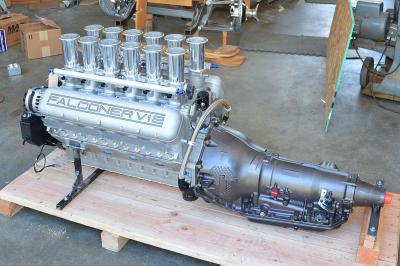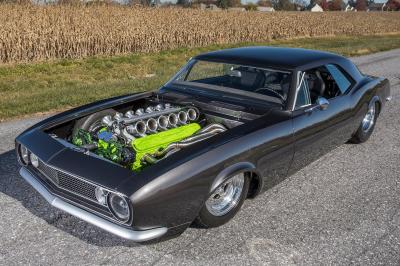How exotic V8, V12 and even V16 engines are created based on serial engines
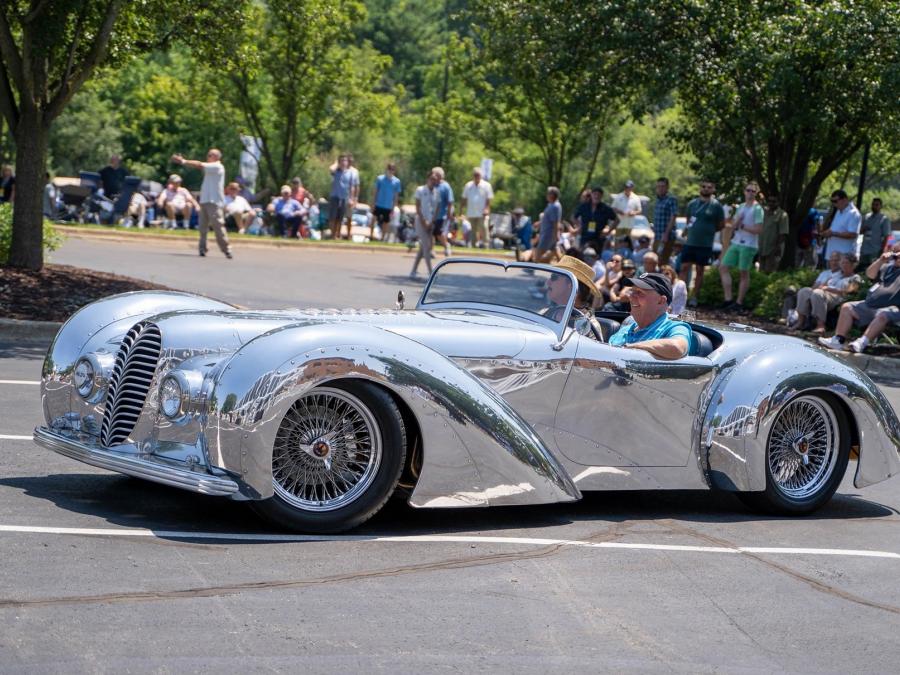
-
Category
-
Author
-
1,104
-
0
-
27Aug, 2022
Small engine builders turn small engines into big ones, and big ones into huge ones.
Even a small firm can create a completely new engine from scratch - of course, if there are competent designers, a foundry and metalworking machines. But it is often more reasonable to take a serial design as a basis ... and “multiply” it one and a half to two times. So you can get a V8 from an ordinary in-line “four” ... or, say, turn a serial V8 into an exotic V12.
By itself, the idea to scale an existing engine did not appear yesterday, and large car builders adopted it a hundred years ago, if not earlier. I will give the most famous examples of such a concept. The inline "six" BMW M30 of the late 60s was obtained by adding a couple of cylinders to the "four" M10. The legendary five-cylinder engines of the Audi EA828 series of the early 80s were created on the basis of the four-cylinder EA827. Subaru SVX's six-cylinder boxer EZ33 is a one and a half times EJ22 engine. And the 12-cylinder BMW M70 engine is, in fact, a pair of M20 “sixes”, united by a common crankshaft.
This approach has a lot of advantages: both the acceleration of design work and the unification of components - you can use the existing parts of the gas distribution mechanism, pistons, connecting rods. It is also convenient for production: ready-made tooling and machining lines are used.
For small motor-building firms, these advantages are even more important. For example, the ability not to waste time and money on choosing the best head design, on testing different options is a great help if your company produces dozens or even units of engines a year!
V8 Honda:
Honda is famous for its four-cylinder engines. For example, back in the late 80s, B-series engines with the VTEC system reached almost motorcycle boost rates, breaking the magical mark of “100 horsepower per liter”.
The K-series engines, produced since the beginning of the 2000s, not only take up space under the hoods of most Honda and Acura models, but have also become super popular in motorsport and tuning: they are put on prototypes for the “ring” and mountain races, installed on cross-country buggies, transplanted in rear wheel drive Fords, Lotus Elise and even Ferraris. But the Japanese company has never mass-produced V8 engines: the maximum is V6.
American engineer Craig Williams dreamed of building a supercar with a 12-cylinder engine of his own design for many years. But in the end I decided to start a more realistic project - to create my own V8. And he admitted that he was inspired by the example of John Hartley!
At first, he thought to take as a basis the legendary F20C engine from the Honda S2000 roadster - the unit that already “spun” up to 9000 rpm from the factory and produced 240 horsepower without a boost. But in the end, I decided to stop at a much more massive and cheaper K24 engine with a volume of 2.4 liters, which in different versions develops from 160 to 205 horsepower. Williams admits that the impetus for the start of work was poor health: the engineer was diagnosed with a serious lung disease, and the design allowed him to distract himself during treatment.
The Neutron K48 engine is a torsional V8 with a classic 90-degree camber angle and a "flat" crankshaft. For the sake of reducing the cost, Williams decided to use standard heads on both sides - for which use two timing chains at once, front and rear.
True, the choice of a V8 scheme with a “flat” crankshaft promised problems with vibrations due to a very long-stroke design: the piston stroke of the Honda engine is 99 millimeters. To get around these difficulties, the designer decided to use ultra-light titanium connecting rods and very compact pistons.
Since production is planned in very small batches, Williams preferred at first to machine the block from a solid aluminum billet. True, not every block can really be made in this way. Therefore, Williams decided to simplify the design: Darton quad cases should be installed in an empty block. And only then, when the design is worked out, it will be possible to switch to casting.
The American took up the design in 2016. The mechanical part is basically completed, the dry sump lubrication system is ready: now the designer is working on the intake system. Williams lays down two versions of the motor. Firstly, a high-speed "aspirated", which should spin up to 10 thousand revolutions per minute and produce up to 700 horsepower. Secondly, a supercharged version with a pair of turbochargers in the collapse of the block. Will we see results soon? Craig Williams hopes to assemble the first prototype by the end of the year - if only he had enough health ...
By the way, the PPR Motorsport workshop is also engaged in a similar project. The Turkish company specializes in the manufacture of original turned blocks and heads - primarily for drag racing. The K44 motor should retain the common architecture of Honda's K-series four, but the block and heads will be made from scratch. Two versions of the engine are supposed: a road V8 4.4 with a capacity of eight hundred forces and a drag version of the V8 5.2 with a capacity of a thousand forces. But this project is still far from completion: judging by the photos on social networks, only the heads are ready yet.
Huge "little blocks"
Chevrolet Small-block eight-cylinder engines are one of the most successful and massive engines in the American auto industry. They power everything from work pickups to Chevrolet Corvette supercars and show surprisingly high boost potential. And they also served as the basis for two V12 engines at once!
The author of one is the American engineer Ryan Falconer. He is a real motorsport veteran: he has been building racing engines since the sixties, even having time to work with Carroll Shelby. His track record includes engines for Indicars, for Can-Am series cars, for various racing projects of the General Motors concern.
Falconer said that back in the eighties, a friend of his suggested combining a pair of Chevrolet V6 turbo engines that they were preparing for the IndyCar series to install them on an airplane. Ryan really liked the V12 engines, but he preferred to build on the time-tested and reliable "small-block" engine.
In 1990, the Ryan Falconer Racing Engines V12 engine was ready. The first prototypes were literally welded to the serial "eight" four more cylinders. But the V12 engines launched into small-scale production were already manufactured in the normal way - by casting their blocks and heads.
By the way, the Falconer V12 is made entirely of aluminum - although the then Chevrolet LT series engines had a cast iron block. But otherwise, he repeated the architecture of the usual "small block": the design of two-valve heads, a 90-degree camber angle, the location of the camshaft in the block ...
Engines were produced ranging from 400 to 600 cubic inches (6.5–9.8 liters): naturally aspirated, turbocharged or driven by compressors. They were mainly used on boats and small aircraft. They were rarely put on cars due to the lack of environmental certificates - mainly on various kinds of hot rods and custom cars. Although in the early 90s, General Motors even built an experimental Corvette ZR-12 with this engine. So GM was going to confront the Dodge Viper - but in the end the project was abandoned due to complexity and high cost: the only prototype built is in the National Corvette Museum on Bowling Green.
A similar motor was introduced in 2016 by the Australian company Race Cast Engines. As you might guess from the name "V12LS", the brothers Matt and Shane Korrish took the "small block" Chevrolet of the previous generation as the basis: the 90-degree camber angle, the location and dimensions of the main components, all the mounting dimensions of the motors of the so-called LS-series are preserved.
The design of the heads and the shape of the channels are "copied" from the Chevrolet LS7 motor - a very successful "power" design. There are two block options: cast iron, with a cylinder diameter of 104.8 mm (as on the 7-liter LS7 engine from the Corvette Z06) and aluminum, with a cylinder diameter of 103.25 mm (as on the LS3 engine with a volume of 6.2 liters). The only crankshaft is steel, with a crank diameter of 92 mm (as on the LS3 motor). This results in two displacement options: 9.2 and 9.5 liters (564 and 580 cubic inches).
On average, such engines with a moderate “civilian” profile camshaft develop about 750 horsepower, with a more extreme one - about a thousand. Curiously, the mass of the engine turned out to be not so large: without attachments and collectors, the aluminum version weighs 191 kilograms. Cast iron is much heavier - 265 kilograms.
The Australians offer both ready-made motors and sets of spare parts for construction by a qualified mechanic. The latter are relatively inexpensive: 39 thousand dollars. We have already seen the Australian V12 under the hood of a custom Chevrolet Camaro, Cheetah Evolution and Factory Five F9R sports cars.
Inline “sixes” of the Toyota JZ series are a real tuning legend: durable engines with cast-iron blocks calmly “hold” 650–700 horsepower, and extreme variants for drag racing can produce over two thousand horsepower.
But the American engineer and hot-rodding enthusiast Don Groff from Minneapolis went a radically different way, assembling a homemade V12 engine from a pair of 1JZ-GTE engines! Instead of making the original V-shaped cylinder block, he cut off the bottom of the blocks and installed them on a homemade crankcase. Moreover, I chose an extremely unusual camber angle - very wide, 120 degrees. The original crankshaft was custom made by SCAT.
Unlike other designers, Don placed the entire timing drive on one side of the motor: for this, one of the heads had to be redone. Moreover, he chose a rather exotic “Hot-vee” layout with a release in the collapse. Initially, he supplied the engine with as many as four turbines, but in the end he simplified the design - he left two turbochargers.
From the idea to the finished car, it took Don almost nine years: the engineer built his motor specifically for the racing “formula” in a retro spirit. Which he not only assembled on his own, but also managed to register as a car for public roads!
